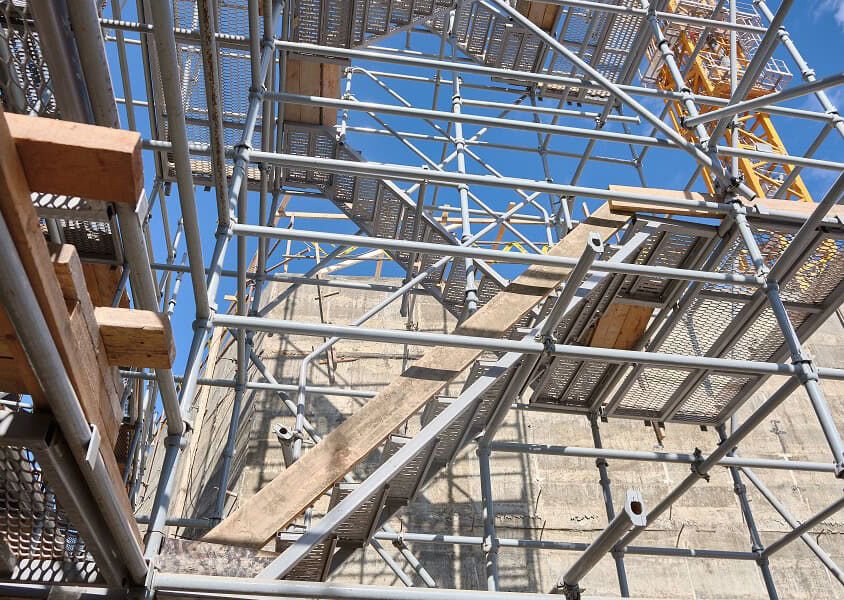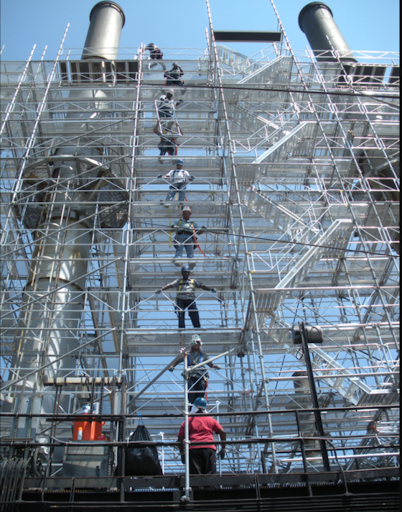High-Quality Residential Scaffolding for Seamless Home Renovations in Surrey
High-Quality Residential Scaffolding for Seamless Home Renovations in Surrey
Blog Article
A Comprehensive Guide to the Necessary Functions of Scaffolding in Modern Construction
The landscape of modern-day building significantly counts on effective scaffolding systems that focus on performance, advancement, and safety and security. As projects grow in complexity, comprehending the necessary features of scaffolding ends up being important for making sure worker safety and enhancing job timelines. This overview discovers various kinds of scaffolding, highlights essential security functions, and examines material developments that add to performance and sustainability. Nevertheless, the implications of these elements extend much past simple building and construction practices, triggering a better take a look at exactly how they affect general job success and worker health.
Sorts Of Scaffolding
Although scaffolding systems can differ commonly in style and application, they normally fall under numerous unique classifications that cater to various construction requirements - Scaffolding. One of the most common kinds include sustained scaffolding, suspended scaffolding, and rolling scaffolding
Supported scaffolding includes systems supported by a structure of posts, which offer a stable and elevated working surface area. This type is usually used for jobs that require considerable altitude, such as bricklaying or external painting.
Suspended scaffolding, on the other hand, is utilized for jobs calling for access to high altitudes, such as cleansing or fixing building exteriors. This system hangs from one more framework or a roof, permitting employees to reduced or raise the platform as needed.
Rolling scaffolding features wheels that allow for simple mobility throughout a work website. It is specifically useful for tasks that require frequent moving, such as indoor operate in big areas.
Each sort of scaffolding is developed with particular applications in mind, making certain that construction projects can be performed successfully and properly. Recognizing these categories is essential for selecting the appropriate scaffolding system to fulfill both task needs and website conditions.
Key Safety And Security Attributes
Safety is extremely important in scaffolding systems, as the prospective dangers related to operating at heights can bring about significant accidents if not correctly handled. Key safety and security features are vital to guarantee the well-being of employees and the stability of the construction website.
Firstly, guardrails are essential. These barriers provide a physical guard against drops, dramatically lowering the danger of significant injuries. Furthermore, toe boards are usually made use of to stop devices and materials from diminishing the scaffold, shielding employees listed below.
One more essential element is the use of non-slip surfaces on systems. This attribute enhances grasp, specifically in negative weather, thereby lessening the probability of falls and slips. In addition, access ladders need to be securely positioned to promote safe entry and exit from the scaffold.
Routine inspections and maintenance of scaffolding systems are additionally vital. These examinations ensure that all components are in great problem and operating appropriately, addressing any kind of wear or damage immediately.
Last but not least, correct training for all employees associated with scaffolding operations is important to make certain that they understand safety procedures and can determine potential hazards. Scaffolding. Jointly, these features develop a much safer working environment and significantly mitigate dangers connected with scaffolding
Product Advancements
Innovations in product scientific research have significantly affected the scaffolding industry, boosting both safety and performance in contemporary construction. The intro of high-strength steel and aluminum alloys has reinvented conventional scaffolding systems.
Furthermore, ingenious composite materials, such as fiberglass-reinforced plastics, have become feasible choices. These products are resistant to corrosion and ecological destruction, therefore extending the lifespan of scaffolding systems, specifically in extreme climate condition. Making use of such materials adds to decrease maintenance costs and makes certain consistent efficiency over time.


Design Factors To Consider
Thinking about the complexities of contemporary construction tasks, efficient scaffolding design is vital to ensuring both capability and safety. Layout factors to consider must include various aspects, consisting of tons capacity, height, and the details requirements of the building and construction site. Each project presents special challenges, demanding a flexible method to scaffolding systems that can adjust to differing problems.
Structural honesty is crucial; consequently, engineers must More hints determine the lots that the scaffolding will certainly support, consisting of workers, materials, and devices. The selection of products plays a critical duty in making sure the scaffolding can withstand these lots while staying light-weight and long lasting. Additionally, the layout has to allow for easy access and egress, assisting in the smooth movement of products and workers.
Security functions, such as guardrails and non-slip surface areas, should be incorporated to reduce risks of accidents. Additionally, the layout must consider the surrounding environment, including nearby structures and potential hazards. By dealing with these design factors to consider, building and construction companies can improve the efficiency of scaffolding systems and promote a safer working setting, inevitably adding to the general success of the job.
Maintenance and Evaluations
The performance of scaffolding systems expands beyond initial style and implementation; recurring maintenance and normal inspections are vital to guaranteeing their continued efficiency and safety and security throughout the period of a project. Normal evaluations should be carried out by qualified workers to recognize any indicators of wear, damage, or instability that can jeopardize the honesty of the scaffolding.
Maintenance methods ought to include routine checks of architectural components, such as slabs, fittings, and structures, ensuring that all aspects continue to be secure and totally free from rust or various other deterioration. Furthermore, the capability of safety and security functions, such as guardrails and toe boards, must be examined to make certain compliance with security laws.
Documentation of all inspections and maintenance activities is crucial for responsibility and governing conformity. A systematic method to record-keeping not just help in tracking the condition of the scaffolding yet also offers needed proof in the occasion of an occurrence.
Ultimately, establishing an extensive maintenance and assessment timetable will substantially lower the risk of accidents and enhance the overall safety of the building and construction site. By focusing on these practices, construction managers can safeguard workers and promote the job's stability.

Conclusion
Finally, the crucial functions of scaffolding in modern construction incorporate a variety of crucial components, including varied kinds, essential safety systems, product advancements, and thoughtful design factors to consider. Highlighting safety with guardrails and non-slip surfaces, together with advancements in materials like high-strength steel, enhances both performance and sustainability. Routine upkeep and evaluations are crucial for making certain structural stability and safety and security on building websites, inevitably facilitating effective job implementation and promoting the wellness of employees.
The landscape of modern-day construction increasingly depends on reliable scaffolding systems that prioritize safety and security, innovation, and effectiveness.Developments in material scientific research have substantially top article influenced the scaffolding industry, improving both safety and performance in modern construction. In general, these material technologies not just boost navigate to this website the efficiency and security of scaffolding systems but also straighten with the market's press towards sustainability, as several contemporary materials are designed to be more eco pleasant.
Thinking about the complexities of modern-day construction jobs, reliable scaffolding design is paramount to guaranteeing both functionality and safety and security.In verdict, the necessary functions of scaffolding in modern building and construction include a variety of critical aspects, including diverse kinds, crucial safety and security systems, product developments, and thoughtful design considerations.
Report this page